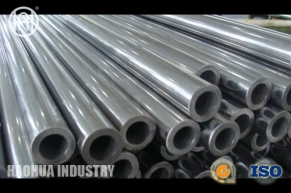254SMO Nickel Alloy Steel pipes
Product Categary:
Main Feature:
Jiangsu Haohua Industry Group as one of the leading suppliers in China to supply 254SMO Nickel Alloy Steel pipes for petroleum industry and Heat Exchanger industry and Machining Industry etc.
product description
254SMO Nickel Alloy Steel pipes
254SMO Chemical composition:
|
Alloy
|
% |
Ni |
Cr |
Mo |
Cu |
N |
C |
Mn |
Si |
P |
S |
|
254SMO |
Min. |
17.5 |
19.5 |
6 |
0.5 |
0.18 |
|||||
|
Max. |
18.5 |
20.5 |
6.5 |
1 |
0.22 |
0.02 |
1 |
0.8 |
0.03 |
0.01 |
254SMO Physical properties :
|
Density |
8.0 g/cm3 |
|
Melting point |
1320-1390 ℃ |
254SMO minimum mechanical properties in the room temperature:
| Status |
Tensile strength |
Yield strength |
Elongation
A5 %
|
|
254 SMO |
650 |
300 |
35 |
The high concentration of molybdenum,chromium and nitrogen made 254SMO has very good resistance to pitting and crevice corrosion performance. Copper improved corrosion resistance in some of the acid . In addition, due to its high content of nickel,chromium and molybdenum, so that 254SMO have a good stress strength corrosion cracking performance.
1.A lot of a wide range use of experience has shown that even iin higher temperatures, 254SMO in the sea water is also highly resistant to corrosion performance gap, only a few types of stainless steel with this performance.
2.254SMO such as bleach paper required for the production of acidic solution and the solution halide oxidative corrosion resistance and corrosion resistance can be compared to the most resilient in the base alloy of nickel and titanium alloys.
3.254SMO due to a high nitrogen content, so its mechanical strength than other types of austenitic stainless steel is higher. In addition, 254SMO also highly scalable and impact strength and good weldability.
4.254SMO with high molybdenum content can make it higher rate of oxidation in the annealing , which after the acid cleaning with rough surface than normal stainless steel is more common than the rough surface. However,has not adversely affected for the corrosion resistance of this steel .
254SMO is face-centered cubic lattice structure. In order to obtain austenitic structure, 254SMO general annealing in the 1150-1200℃.In some cases, the material maybe with the traces of metal middle phase (χ phase and α-phase). However,their impact strength and corrosion resistance are not adversely affected in normal circumstances. When placed in the range of 600-1000℃, they may phase in the grain boundary precipitation.
254SMO with very low carbon content, which means that the danger by the heating caused of carbide precipitation is very small. Even in the 600-1000℃ after one hour sensitization still able to Strauss through the intergranular corrosion test (Strauss Test ASTMA262 order E).However, because of the high-alloy steel content. In the above-mentioned temperature range intermetallic phase with the possibility of metal in the grain boundary precipitation. These sediments do not make it occur intergranular corrosion in the corrosive media applications, then,welding can be carried out without intergranular corrosion.But in the heat of concentrated nitric acid, these sediments may be caused intergranular corrosion in heat-affected zone. If ordinary stainless steel in the solution that containing chloride, bromide or iodide,it will show pitting, crevice corrosion or stress corrosion cracking form by localized corrosion. However, in some cases,the existence of halide will speed up the uniform corrosion. Particularly in the non-oxidizing acid. In pure sulfuric acid, 254SMO with a much greater corrosion resistance than 316(common stainless steel),but with abated corrosion resistance compared to 904L (NO8904) stainless steel in high concentrations. In the sulfuric acid containing chloride ions , 254SMO with the largest corrosion resistance ability.The 316 can not be used for stainless steel in hydrochloric acid since it may occur localized corrosion and uniform corrosion, but 254SMO can be used in diluted hydrochloric acid in general temperatures,uder the border region do not need to worry about corrosion occurred. However, we must try to avoid the gap cracks. In the fluoride silicate (H2SiF4) and hydrofluoric acid (HF), the corrosion resistance of ordinary stainless steel is very limited, and 254SMO can be used in a very wide temperature and concentration.
1. Petroleum, petrochemical equipment, petro-chemical equipment, such as the bellows.
2. Pulp and paper bleaching equipment, such as pulp cooking, bleaching, washing filters used in the barrel and cylinder pressure rollers, and so on.
3. Power plant flue gas desulphurization equipment, the use of the main parts: the absorption tower, flue and stopping plate, internal part,spray system.
4. At sea or sea water processing system, such as power plants using sea water to cool the thin-walled Condenser, desalination of sea water processing equipment,can be applied even though the water may not flow in the device.
5. Desalination industries, such as salt or desalination equipment.
6. Heat exchanger, in particular in the working environment of chloride ion.






